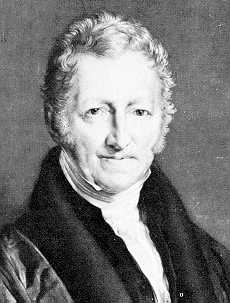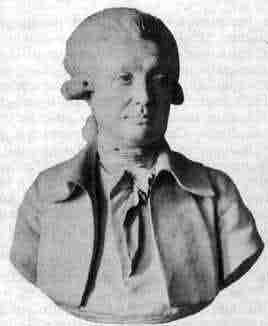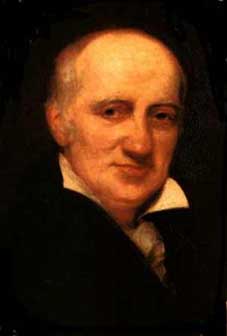| | Return to the Table of Contents | |
The Classical School--Thomas Malthus Thomas Robert Malthus (1766-1834) Akama's database, [??]
In
Defense of Malthus, by Morgan Rose, September 16, 2002, Teacher's Corner,
The Library of Economics and Liberty
|
 M.J.A. Nicolas de Caritat, Marquis de Condorcet (1743-1794) Akama's database, [??] |

William Godwin (1756-1836) Akama's database, [??] |
Malthus's theory of population argued that population grows at a geometric rate while food output grows at an arithmetic rate and that food scarcity was, therefore, inevitable. In other words, nature imposes firm limits on our pursuit of a higher standard of living. Malthus argued that, in the absence of preventive checks on population growth—these are lifestyle changes that reduce the birth rate—more painful positive checks—which raise the death rate—will be imposed by nature.
Malthus defined the subsistence wage as a wage at which the size of the working population does not change. If the wage exceeds the subsistence wage, population would grow rapidly owing to the workers' lack of what Malthus called "moral restraint". This increase in population would tend to reduce wages. If, on the other hand, the wage falls below the subsistence wage, population would fall rapidly owing to hunger. This fall in population would tend to increase wages. As a result, wages would in the long run be equal to the subsistence wage.
Neither technological progress nor government generosity would make any difference to the workers' standard of living. Only "moral restraint" would help. Suppose the subsistence wage is currently 2 tons of wheat a year. That is, suppose this is the wage at which the working population stays constant; at any higher wage the population grows and grows. As a result, the workers' long run wage would be 2 tons of wheat per year. Now suppose that as a result of moral restraint exercised by workers the subsistence wage increases to 3 tons of wheat a year. That is, now the working population would grow only if the wage rose above 3 tons of wheat a year. In this case, the long run wage would also rise to 3 tons of wheat a year. In this way, Malthus argued that only "moral restraint" by workers could improve their standard of living.
Malthus had little faith that preventive checks (or, "moral restraint") would solve the problem. He even argued that society might wish to do whatever it could to hurry along nature's positive checks. Malthus joined the contemporary policy debate on the Poor Laws to oppose public assistance to the poor because such assistance would only swell the ranks of the poor and make the eventual reckoning with nature's positive checks all the more painful. After gaining immense fame (or, notoriety) because of his ideas, Malthus in his later years back-pedaled somewhat and became an advocate of gradualism.
The theory of population used by Malthus had been proposed earlier by Giovanni Botero and Richard Cantillon. Malthus's theory that agricultural output would grow at an arithmetic rate even though the labor force may be growing at a geometric rate depended on the notion of diminishing returns in production. Although this notion of diminishing returns must have been obvious to observant people, its analytical treatment was provided by Turgot, who had used diminishing returns to construct a theory of investment. What Malthus added were his analyses of the effect of various policy measures, of technological progress and of "moral restraint" on population and the long run standard of living.
Malthus may have been rebelling against his father who had been influenced by the utopian writings of William Godwin, the Marquis de Condorcet and Bishop Paley. These writers had argued that human beings would figure out the right way on their own. Paley, in particular, welcomed the prospect of a larger population. Malthus saw this optimism as seriously misguided.
Malthus also proposed a theory of market gluts in which an excess of supply over demand was regarded as possible. Malthus felt that the key to avoiding such gluts, which would lead to unemployment, lay in the amount spent by the land-owning class. If they spent freely, there would be adequate demand and unemployment would be low. One way to ensure this, Malthus argued in his contribution to the debate on the Corn Laws that had imposed tariffs on imports of cheap corn, was to retain those tariffs. This would raise the price of British agricultural produce, raise the incomes of the landlords, increase their spending and thereby avoid the occurrence of a market glut. (Elements of this theory was later revived as the Keynesian theory of the short-run role of tariffs under fixed exchange rates.)
Malthus's theory of population has by and large been proven wrong; there have been astonishing increases in agricultural productivity in advanced countries. However, Malthus was right in the sense that the problems of overpopulation and famine have not disappeared entirely. Besides, even rich countries may be faced with a different version of the Malthus scare in the ruin that their growth has wrought on the earth's environment.
Malthus's theory of population focused economists' attention on land use and land rent. The main innovator on these issues was David Ricardo, who I will be discussing next. Ricardo, while being a friend and benefactor to Malthus, was also his chief opponent in the Corn Laws debate.
| | Return to the Table of Contents | |